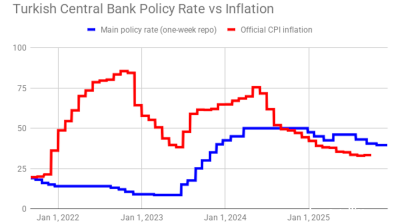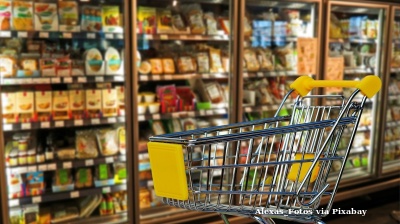Russia's international reserves are back above $600bn after they increased by $4.1bn to $601.3bn as of July 12, 2024, according to the Central Bank of Russia (CBR). (chart)
The CBR’s official reserves count includes some $300bn frozen in the West by sanctions, as technically the money still belongs to the CBR, even if it can’t spend it.
Reserve assets decreased by $1bn in the second quarter of 2024 due to operations involving the National Wealth Fund. However, the overall level of international reserves rose by $3bn to $593bn as of July 1, 2024, due to revaluation and other changes.
At the same time Russia's foreign debt declined by 3.4% y/y to $306.1bn as of July 1, the Central Bank said. The unfrozen part of Russia’s reserves is enough to pay off the entire external debt tomorrow in cash. (chart)
“Dynamics of the indicator was largely driven by the decline of liabilities of other sectors on credits and loans borrowed, including with the framework of direct investing relations,” the regulator said. The Russian foreign debt stood at $340.77bn as of July 1, 2023.
National Wealth Fund flush
Russia’s rainy-day fund, the National Welfare Fund (NWF), also remains flush, holding enough money to pay this year’s estimated budget deficit of RUB1.6 trillion, or 0.8% of GDP, by inflowing earnings from oil exports. The budget deficit fell to RUB929bn ($10.6bn), or 0.5% of GDP, by the end of the second quarter of 2024. (chart)
The volume of the NWF amounted to RUB12.6 trillion ($146.96bn) as of July 1, 2024, or 7% of the GDP forecast for 2024, according to the Ministry of Finance. This is a slight decrease from RUB12.7 trillion ($144.83bn) as of June 1. The liquid assets of the NWF totalled RUB4.603 trillion ($52.53bn), down by around RUB443bn ($5.05bn) from the previous month. That is enough to cover this year’s projected deficit almost three times over.
The Ministry of Finance reported that total revenues from placing the funds in permitted financial assets, excluding those in accounts with the CBR, amounted to RUB38.584bn ($426.5mn) in 2024. "The total revenues from placing the funds in permitted financial assets, with the exception of funds in accounts with the Bank of Russia, in 2024 amounted to RUB38.584bn, which is equivalent to $426.5mn," the Ministry said.
Export and import dynamics robust
Russia’s external trade remains robust, as almost all the country’s export of oil has found new markets in Asia and oil prices have risen, thanks to OPEC output reductions, to over $80 a barrel.
In the second quarter of 2024, the value of exports increased despite a slight decline in physical volume, due to foreign restrictions on Russian metals and voluntary reductions in oil production and exports, the CBR said in a recent update. “Higher oil prices supported export values, with Brent crude averaging $85 per barrel, up 8% y/y, and Russian Urals crude rising by 31% y/y to $69 per barrel,” the CBR said.
Imports continued to decrease, down 8% y/y, despite rising domestic demand. This decline was partly offset by higher domestic production and import substitution efforts, according to the CBR. The share of European imports fell to 26% from 29% in the same period in 2023, while the share of Asian imports rose to 67% from 64%.
Financial account in surplus
The financial account surplus (excluding reserve assets) expanded to $17bn in the second quarter of 2024, up from $6bn in the second quarter of 2023, the CBR said.
“Growth in foreign assets, driven by export proceeds and increased receivables, was a key factor. Foreign assets grew by $17bn, while foreign liabilities increased by $1bn, partly due to accumulated unpaid dividends to non-resident investors from unfriendly jurisdictions,” the CBR said.
Current account surplus
Russia's current account surplus climbed to $18bn in the second quarter of 2024, up from $8bn in the same period in 2023, to bring the cumulative total to $43.2bn.
“This growth was primarily due to a 6% y/y decrease in imports, exacerbated by logistical challenges, and a 1% y/y increase in export value, bolstered by higher oil prices and increased external demand,” the CBR said.
Russia is on course to end the year with a current account surplus of some $85bn, more than last year’s $51bn, but less than the extraordinary $265bn it earned in 2022 before oil sanctions were imposed. Supportive global oil prices and insufficient sanctions enforcement suggest that risks are to the upside, the CBR says.
Customs revenues
The largely unfettered trade means cash is pouring into the Kremlin’s coffers. In the first half of 2024, the Russian Federal Customs Service (FCS) has transferred RUB3.361 trillion ($38.23bn) to the budget, FCS head Valery Pikalev said at a working meeting with Russian President Vladimir Putin on July 19.
"With regard to the management of customs payments, I can report the following – in the first half of the year, the collected revenues amounted to RUB3.361 trillion. At the same time, the effectiveness of customs control has increased, with RUB11bn being recovered under the risk management system," he said, TASS reports.
Putin said that customs duties in the first half of 2024 rose by RUB500bn ($5.69bn). "The Federal Customs Service is doing its job. In the first half of this year, almost RUB500bn more fees and payments were transferred than in the same period last year," Putin said.
Economy starting to cool
Nevertheless, there were signs of a slowdown in economic activity in July, according to the CBR. The business climate indicator, calculated by the Bank of Russia based on surveys of enterprises, decreased noticeably in July (by 2.9 percentage points to 7.7%), according to the latest macroeconomic survey.
“It’s persistence in the positive zone indicates that business activity continues to grow, but at a slower pace. The main factor was a decrease in enterprises' estimates of current demand and output,” Renaissance Capital said in a note. “In addition to the labour shortage, respondents noted difficulties in paying for the import of raw materials, components and equipment.”
Business expectations for future demand and output continued to decline, although at a slower pace than in June. Price expectations of enterprises (the difference between the number of respondents expecting an increase and a decrease in prices in the next three months) in July remained at the level of the previous month.
Lending conditions continued to tighten at an even faster pace: respondents noted both an increase in rates and a tightening of non-price conditions.
Data

Turkey's central bank remains cautious, delivers 100bp rate cut
Decision comes on eve of next hearing in trial that could dislodge leadership of opposition CHP party.

Polish retail sales return to solid growth in September
Polish retail sales grew 6.4% year on year in constant prices in September, picking up from a 3.1% y/y rise in August, the statistics office GUS said.

Uzbekistan’s nine-month foreign trade nears $60bn
Export growth of 33% and import expansion of 16% y/y produce $6.4bn deficit.

Hungary’s central bank leaves rates unchanged
National Bank of Hungary expects inflation to fall back into the tolerance band by early 2026, with the 3% target sustainably achievable in early 2027 under the current strict policy settings.




